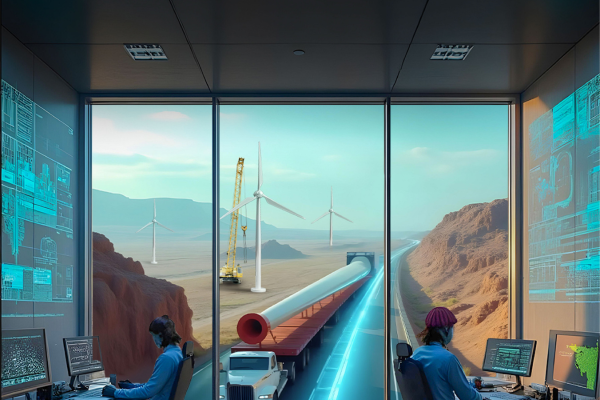
Wind Turbines and AI: Intelligent Operations, Increased Efficiency
Wind energy days are becoming smarter no. It takes longer to install Wind turbines than towers and blades. AI (artificial intelligence) revolutionizes operations, maintenance and power generation. Predictive maintenance, advanced monitoring and intelligent planning of energy generation are part of AI-based Wind energy installation, which increases efficiency and certainty.
AI-Driven Monitoring of Wind Turbines
Artificial intelligence technology is able to scan and interpret huge volumes of data from wind turbines. Sensors track blade pitch, vibration, wind speed and temperature. AI software is able to detect anomalies before failure, minimizing downtime. Predictive maintenance is changing wind farm installation maintenance from reactive to predictive and allowing turbines to be run at their maximum capacity.
Operational-level decision-making is data-driven. For example, AI dynamically adjusts yaw and pitch of blades to achieve maximum energy under changing wind conditions. It permits smoother output of wind farms and reduced cost of operation throughout the lifetime of turbines.
AI ensures accurate prediction of wind patterns and efficiency of the turbines. By having access to historical trends, predicted weather and real observation, the operators are able to schedule the operation of the turbine so as to generate the optimal level of power. Efficiency is ensured and return on investment on average terms is guaranteed in Wind Turbine Installation projects.
Generation information is also helping with stability in the grid. Artificial intelligence technology is utilized to predict variations in generation and allow the turbine or the storage unit to be driven so that supply and demand can be matched. Wind Energy electricity is therefore predictable and blended with nonrenewable and renewable energy sources.
Less Downtime and Predictive Maintenance
Maintenance is the most expensive part of wind farm installation. Predictive maintenance using AI is a technique that detects probable failure of components prior to actual failure. It prevents unforeseen breakdown, saves repair time and cost and maximizes overall effectiveness of Wind power installation.
Predictive models consider trends in the operation of the turbines to propose the best time to replace parts. Continuous monitoring of generator, blade and bearings is expensive and time-consuming. Running such turbines uninterrupted yields maximum power and maximum long-run efficiency.
AI and Smart Turbine Placement
Artificial intelligence is also used to support planning and streamline the new sites for Wind Turbine Installations. AI models consider topography, direction of the wind and environmental limiting factors in selecting the best turbine location. Positioning optimally minimizes turbulence between turbines and maximizes Wind energy installation efficiency.
Old turbines are in a good position to limit wake effects, improve energy efficiency and minimize mechanical stress. On top of that, this optimizes turbine lifespan and installation cost of Wind farms, thereby becoming affordable.
The Incorporation of AI in Wind Farm Operation
AI is not applied to one turbine. AI systems control wind power plant installations. The systems optimize production, plan maintenance and track the carbon footprint of the Wind farm.
Operators also take smart choices in real time on the basis of AI inputs, ranging from shutting down turbines during bad weather to controlling spinning blade angles for maximum possible production. Smart management thus achieves maximum energy production without high wear and tear.
Better Sustainability and Eco-Friendliness
AI also enables cleaner operations. Optimized turbining operation eliminates wastage of energy, thereby making Wind turbine installation projects cleaner. AI is also able to monitor wildlife movement around turbines to ensure not too much disturbance of the surrounding ecology and wind energy installation being environmentally friendly.
Predictive analytics also prevents over-production of energy and emissions during maintenance. AI optimizes the carbon footprint of wind energy schemes more effectively with wind farm installations, positioning the role of renewable energy in sustainable development.
Minimizing Costs and Optimal ROI
Cost advantages are the direct consequence of improved efficiencies through AI implementation. There is reduced hours out-of-commission, reduced maintenance expense and improved energy return, enabling wind power installation project operators to achieve return on investment.
AI-based insights result in best-in-class resource scheduling and accurate energy forecasting. Improved decision-making enables wind farms to drive at or near peak capacity, which ensures optimal return on Wind turbine installation projects and riskier investors.
AI-Driven Smart Maintenance Teams
AI also facilitates maintenance crews. All the operations are guided in AR and AI for inspection and repair by the technicians. This minimizes the risk of human error, is time-saving on service and improves onsite safety. The crews can make the most of the work by scheduling the jobs to align with the schedule that real-time analysis of AI anticipates to deliver a better and more efficient wind energy installation process and reduced downtime.
There are also AI drone scans that identify cracking or erosion on blades and towers. This reduces risk to human resources and puts wind farm installation projects in a place where they are always operating without subjecting them to downtime periods.
Future Trends in AI and Wind Energy
Artificial technology will no longer be shunned for future wind power. Drones and robots will automatically inspect, AI sensors automatically detect micro-faults and machine learning algorithms automatically optimize generation plans. Installation activity will be less expensive, shorter and safer.
Virtual copies of the Wind farms and land-based AI will enable experimentation with performance in various conditions of land by the operator. Predictive technology improves installation efficiency, decreases risk and maximizes planning for the entire Wind farm.
Conclusion
AI is turning Wind Turbine Installation into a smarter, faster and better process. From AI-powered energy generation to site optimization for turbines and maintenance as preventive care, the benefits are astronomical. Wind power installation is being revolutionized from mechanistic to smart money-saving, energy-generating maximizing and environmentally friendly.
To investors and operators, incorporating AI for wind farm installation guarantees long-term performance, minimized risks and maximized returns. AI technology for wind power installation is now a necessity and no longer a luxury for future-proof, high-performance and sustainable wind power systems.
